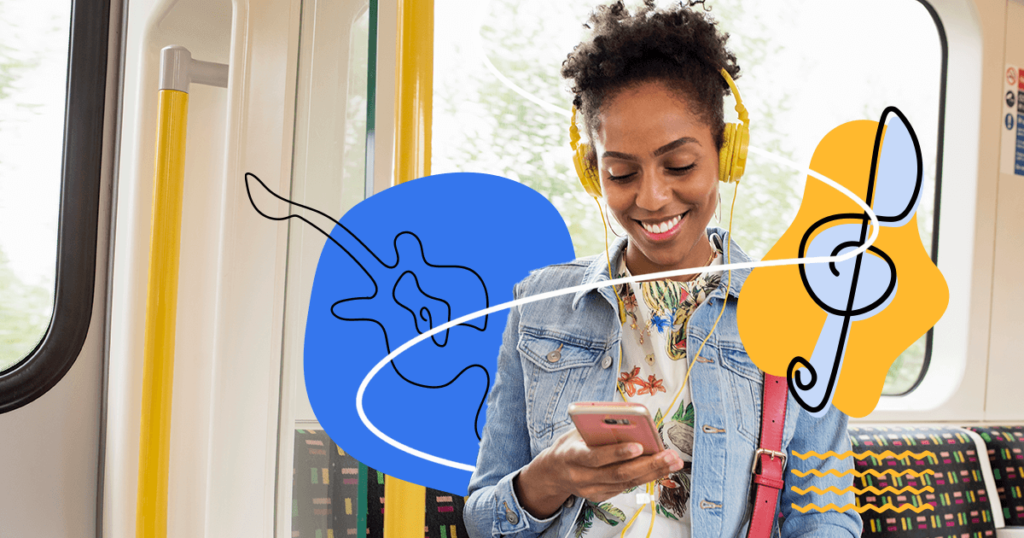Spotify, one of the world’s most popular music streaming services, has announced a major redesign this month – and it seems that the intention of the platform’s redesign goes far beyond just being a “fresh look”.
The changes include features already known to the active public on social networks like TikTok, Instagram and YouTube, and have very interesting strategies to engage users who only use the music app to, well, listen to music.
One thing we can say is that the redesign aims to create a more personalized and engaging experience for users, taking the focus on discovering new music to the next level and offering a new way for users to find and share music, interact with artists, and connect with other music lovers.
But what does that say to marketers and companies? Well, I’ve taken a closer look at these changes and identified three key points for marketers and companies to be aware of. Check it out:
Keep both eyes on the market
Spotify has been showing the path it wants to follow for some years now, investing more and more in the design and storytelling of Spotify Wrapped (and promoting a viral effect every year, with new data and lots of interactivity), in expanding the podcast space, in adding audiobooks onto the platform and, more recently, showing short videos of the songs while they’re playing.
But some of the most significant changes announced this month are the addition of a “Discover” tab, which has already appeared on the user’s homescreen with some personalized music recommendations based on their preferences, and the “What’s New” feed, which shows the latest releases from artists and podcasts that users follow.
These two features have been designed to make it easier for users to find new music, artists, and content that they might be interested in, based on their friends’ interests and the users’ listening history. Seems familiar, doesn’t it?
For me, this social aspect is reminiscent of TikTok, where users can discover new content based on what their friends and influencers are sharing. Considering that TikTok’s algorithm has been incredibly successful, it’s no surprise that Spotify has taken inspiration from it.
But don’t forget: the real algorithm goal is to keep users engaged and ensure they keep coming back to the app, something that TikTok has already proven to be very efficient at – and that’s why it was the favorite platform of marketers to invest money in for 2022.
Interactivity breeds engagement – and rich data
And speaking of engagement, with these changes it is possible to say that Spotify is investing more and more in interactivity with its users.
The “Only You” feature, for example, generates personalized playlists based on a user’s listening history, and the “Blend” feature allows two users to merge their musical tastes into a collaborative playlist.
Additionally, the “Enhance” feature enables users to adjust the sound quality of their favorite songs, while the “Greenroom” feature allows users to host live audio conversations with other Spotify users. These new interactive changes on Spotify not only provide a more personalized experience for users, but also offer opportunities for social interaction and community building within the platform, increasing users’ engagement.
By continuously improving its interactivity and engaging features, Spotify is positioning itself as the go-to destination for music lovers worldwide.
But beyond that, Spotify is learning more and more about its users’ behavior through very rich first-party data – and this is one of the most assertive strategies from the largest music streaming platform in the world.
After all, collecting first-party data provides several benefits for marketers and companies. Firstly, it allows marketers to gain a deep understanding of their customer’s behavior and preferences, which can be used to create personalized marketing campaigns that resonate with the audience, which can lead to higher conversion rates and customer loyalty.
Secondly, first-party data provides insights that can be used to optimize marketing strategies and improve business operations: for instance, analyzing behavioral history data can help marketers identify high-value customers and tailor promotions and offers to their needs.
Thirdly, by collecting first-party data, marketers can reduce their reliance on third-party data sources, which can be less reliable and pose privacy concerns.
Overall, collecting first-party data enables marketers to make data-driven decisions and deliver better customer experiences, ultimately leading to increased revenue and business growth.
If you still don’t know how to collect this type of data from your users, generate interactive experiences and increase the engagement of your content, try a free Ion demo and learn how to create unforgettable experiences while generating fundamental data for your content marketing strategy.
Explore different Ad formats
Another major change is the introduction of video content. Spotify now includes video podcasts, as well as a new feature called “Canvas,” which allows artists to upload short looping videos that play in place of album artwork. This feature is similar to the short-form videos on Instagram and the music videos on YouTube.
The addition of video content is a clear attempt to keep users engaged for longer periods of time and to compete with other video-focused platforms. But, we all know what this really means for marketers: new ways and formats to promote video ads on Spotify.
Video advertising on Spotify can provide several benefits to businesses looking to increase their brand awareness and reach their target audience.
With access to Spotify’s first-party data, businesses can target their video ads based on factors such as age, gender, location, listening habits, and interests, ensuring their message is seen by the right people. This helps not only to increase the effectiveness of the ad, but it can also result in higher conversion rates.
The new Spotify format also allows businesses to create engaging and memorable content that resonates with their audience. That’s because video ads can help businesses tell a story, showcase their product or service, or even offer a behind-the-scenes look at their business – and build a stronger connection with their audience and increase their chances of turning them into loyal customers.
In conclusion, we can say Spotify’s new features have opened up new avenues for marketers to connect with their audience and create highly targeted and engaging campaigns.
By leveraging these new features, businesses can stay ahead of the curve and reach their marketing goals on one of the most popular streaming platforms in the world, as it is essential for businesses to stay up-to-date with the latest trends and technologies to maximize their marketing efforts and achieve success.
With Spotify’s new features, marketers now have an opportunity to create even more impactful campaigns that connect with their audience and drive business growth – and no one wants to stay out of tune, right?
Do you want to continue to be updated with Marketing best practices? I strongly suggest that you subscribe to The Beat, Rock Content’s interactive newsletter. There, you’ll find all the trends that matter in the Digital Marketing landscape. See you there!







